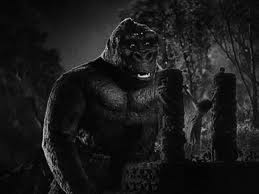Cat People
One of the
main problems with old horror films is that they are not really scary. I mean,
they are usually more “horrible” than “horror”. So when I see them they need to
be good for other reasons. Ambience, dialogue, plot or something like that.
“Cat People” is one of the first films from the list that has no such problem.
It is genuinely suspenseful and scary. It really works as intended even today,
or at least on me.
Instead of
using blood, gore and chock effects it builds up a terrifying feeling that
something terribly bad is about to happen and it almost does several times.
Each time we breathe out in relief, but the danger is not over, just postponed.
When disaster strike it is exactly as terrible as we feared, though the target
may be a surprise (well, maybe not if you apply a few solid Hollywood
conventions…).
The film
owes a lot of its efficiency to the film noir elements so pronounced here.
There are lots of night scenes with deep shadows and a lurking darkness. The
evil in the dark is hinted at, visually with shadows and in the dialogue, but
rarely do we see anything actually materialize. Besides being a very efficient
tool to scare the viewer as our imagination willingly fill in the blanks it
also supports the question of imagination versus reality, which I will return
to in a bit. Two highlight is Alice(Jane Randolph) walking the empty alley at
night with footsteps approaching and suddenly they are gone and we only see a
rustling in the bushes and secondly the swimming pool scene where the shadows
on the walls becomes terrifyingly alive. Where is the danger coming from? It is
all around her and closing in. Brilliantly done.
Another
element of the film noir genre is the fatalistic gloom. It starts on a down and
it just gets worse. There is no way out for Irena (Simone Simon), she is caught
in her fate and the question is just how many will go down with her. Even in
the happiest moments like her wedding is there a shadow hanging over her.
A long way
into the film we do not know if Irena is a mentally troubled woman of if she
really turns into a panther in moments of lust and passion and that is a really
strong point of the movie. In the beginning she strikes me as a woman with a
bad depression. She feels unworthy and less than perfect and uses the cat issue
to pommel herself. She feels she needs punishment and so she inflict it on
herself with the restriction and doom the cat story gives her. Later however it
sounds more like schizophrenia, almost a Dr. Jekyll and Mr. Hyde case, where
her normal state is very restrained and controlled, lacking any sort of emotion
except for a fatalistic sadness, whereas her “cat” phase is unrestrained
emotion; hunger, lust, hatred and passion. Those things are believed dangerous
and run amok like here they are really lethal. Irena hates that and fear it and
as a result she bars it away with the result that it explodes when it comes
out. The changes being so violent that it is a complete personality change.
------SPOILER------
Or is it
so? The other explanation is that she is right, that the fantastic story that
she is a descendant of some satanists in Serbia who turns into big cats at
night and therefore prone to the same condition, is true. It is entirely
unrealistic and that is also the course the film takes, yet the suspicion
sneaks in on us that maybe, just maybe there is something to it. The fact that
we do not really see anything leaves us guessing.
Unfortunately
at some point we do see the panther and if we are supposed to believe what we
see the answer to the riddle is given. That opens up for a dramatic end, but at
the sacrifice of some of the mystery. Personally I would have preferred to be
left guessing. She could still have mangled and killed the psychiatrist even if
she was just her crazy self.
------END
OF SPOILER-----
Yet despite
this the finale is still powerful enough to keep me in suspense and leaves me
quite satisfied with the movie.
That is not
to say that the film is faultless. I am particularly questioning the sudden
relationship between Irena and Ollie (Kent Smith). We are to believe that he is
magically attracted to her and she is despite herself reaching out for another
person so in a split second they are married. That is a very very thin basis
for a marriage even in 1942. It may be that he feels some need to help her, but
really, she need a friend more than she need a lover and true enough it becomes
their undoing and therefore I feel that the marriage is a tool for the story
rather than a natural course of events. Contrived really.
Also the psychiatrist
(Tom Conway) is not entirely believable as a psychiatrist. He come about rather
arrogant with some easy answers and seems quickly to give up on her. If it
really is a mental illness they need to talk and talk and talk and he has to
accept that she will be protecting the story to the end. On top of that it is
highly unprofessional that he gets emotionally involved with his patient. That
is a huge no-no.
Those are
details and if the basic horror element had been lacking they could have been
problematic. As it is I forgive them. The film works in its primary function and
that is what counts.







